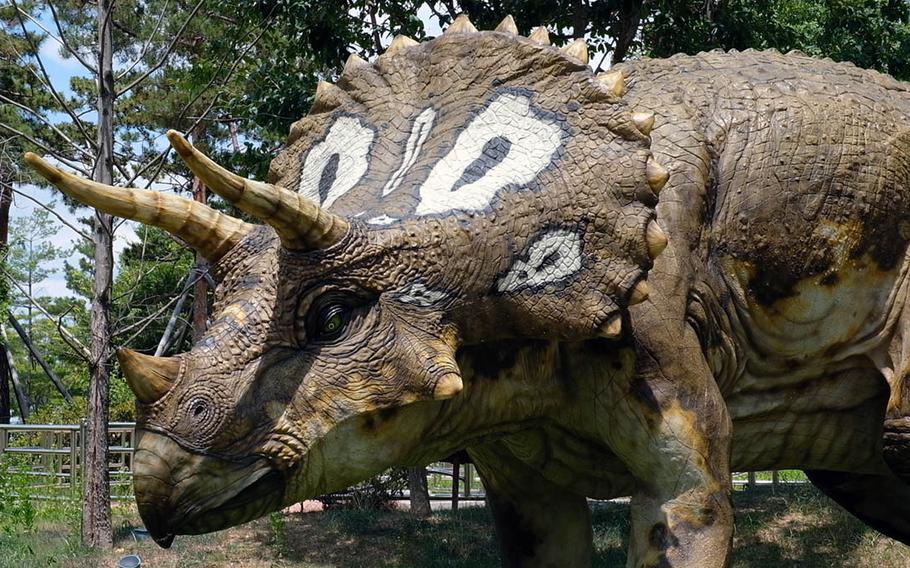
A model Triceratops, along with other dinosaurs, are displayed outside the Gwacheon National Science Museum in Gwacheon, South Korea, shown here on Tuesday, July 9, 2019. (Matthew Keeler/Stars and Stripes)
Tell the kids you’re taking them to spend a day at a museum and, if they are anything like mine, they will probably wish they had get-out-of-jail-free cards in their back pockets.
However, the Gwacheon National Science Museum in Seoul turned out to be so much more than just a leisurely stroll through countless halls past endless placards and countless relics.
Located just south of the Han River, the two-story complex features 10 themed halls and hundreds of exhibits that take visitors back to the formation of the galaxy and into the future.
Along this journey, visitors can explore all areas of natural science and understand the scientific principles that are hidden in our daily lives.
The Basic Science Hall is a great place for parents to introduce young minds to basic principles and theories of natural science using their eyes, ears, hands and body. It consists of 110 exhibits that dabble in physics, chemistry, biology and earth science.
Among them are more than 70 hands-on exhibits that encourage interaction, especially the earthquake and typhoon simulators. Expect to get soaked in the typhoon experience, but, thankfully, full-body rain suits are available.
The centerpiece of this hall is a Tesla coil that generates 4 million volts. Each hour, a staff member will give a very brief lesson for visitors. Although the lesson is in Korean, hang around for the finale as the coil discharges its enormous energy out to surrounding rods that act as grounds.
So much time could be spent in the basic hall, but don’t neglect the other areas, such as the Natural History Hall. Here, you will be transported through the birth and evolution of the universe and life itself.
On display is a 90 percent authentic fossil of an Edmontosaurus dinosaur as well as additional skeletal structures of dinosaurs and mammals from the same period.
There is so much to see and do, including eight more exhibit halls in the main building alone.
Visiting a museum of this magnitude could be exhausting not just for the mind, but also the body. Fortunately, a food court offers Korean-style rice and noodle entrees, hamburgers and a selection of frozen sweets and candy for that additional energy pop. There’s also a lounge out back inside a train car that serves fresh sandwiches.
Outside the main hall, visitors will find a dinosaur park, a planetarium, a full-sized South Korean Naro-1 rocket and an insectarium.
If the kids like all things icky, be sure to visit this exhibit, which features beetles, worms, bees, spiders and more. One exhibit allows you to place your arm into a swarm of bees. Apparently, they don’t have stingers, but I wasn’t willing to test that.
The show inside the planetarium included a tour of the constellations within our galaxy, although the presentation is in Korean, as are all the museum shows.
At just 4,000 won (about $3.50) per adult and 2,000 won per school-age child, this museum is an absolute educational family fun day.
keeler.matthew@stripes.com Twitter: @MattKeeler1231
DIRECTIONS: By train, take the No. 1 line to Geumjeong Station and transfer to the No. 4 line to Seoul Grand Park. Take exit 6 at the station.
TIMES: 9:30 a.m. to 5:30 p.m. Sunday to Saturday; closed Mondays, Jan. 1, Lunar New Year and the Chuseok holiday.
COSTS: 4,000 won for adults; 2,000 won for children ages 7-19; free for kids younger than 6.
FOOD: A food court is available on the second floor with Korean-style rice and noodle meals, and a hamburger stand. Outside is a lounge that offers fresh sandwiches.
INFORMATION: Phone: 02-3677-150; Online: sciencecenter.go.kr/scipia/?lang=en